Venerdì, 20 January 2023. Castlegregory
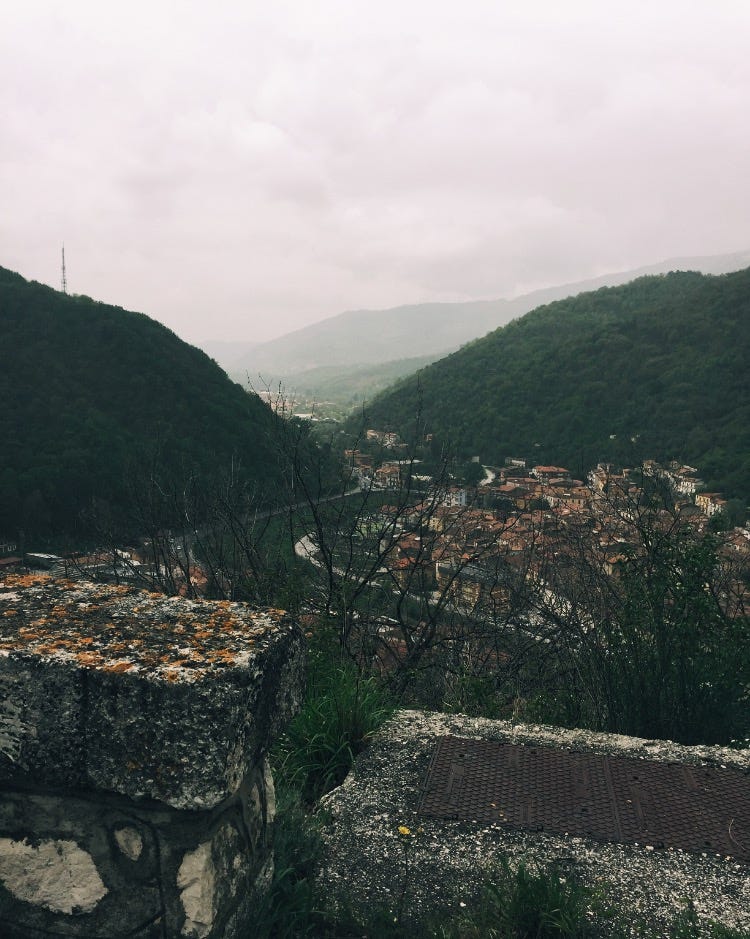
I did not know, like so many, the Sabine villages nestled like jewels in the blanket of the Apennine mountain range and their ability to reflect the riches of this region’s cultural and culinary heritage. Carried on crystal currents toward the capital, they can sometimes be unapologetically claimed in this space.
I first passed through Antrodoco, whose name is derived from the Latin Interocrea which means “between the mountains”, on our way to a high altitude wedding. Unfamiliar with the Apennine vibe, I was dressed in a royal blue one shoulder frock from Max Mara, an inappropriately high pair of gold satin heels and pair of vintage earrings (lost somewhere on the side of the road) as I listened to my history buff boy explain our surroundings. Passing through the deep valleys and looming canyons carved by the Velino river, he noted Antrodoco as a place where you could buy a good pair shoes and great gelato before pointing to Mussolini’s DUX spelled out on fascist forest pined slopes of Monte Giano. At the time he did not mention how this area has been exploited for its riches, the water used to hydrate Rome since ancient times, and how the traces of the equally ancient via Salaria can still be found as proof of this valley’s importance as a transportation hub. He also forgot to mention the chestnuts.

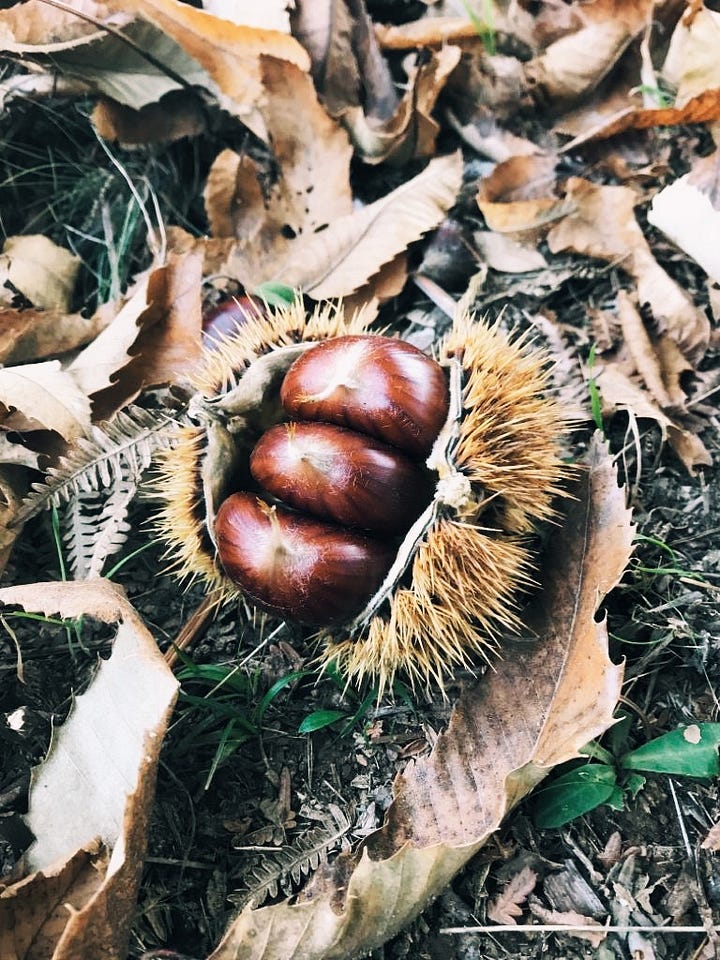
The chestnut has an important place in Italian regional cooking, with each species unique to the environment which gives it shape. The highly sought after and superior Marrone Antrodocano is cultivated in the grove covered landscapes of the municipalities of the Valle del Velino, in the northeastern part of Rieti bordering Abruzzo. Passing though this region, it is easy to imagine the historical ongoings and rural rites exchanged between countryfolk throughout the centuries speaking in their Sabine-Aquila dialect as they harvested and treated these fruits for consumption between mid-September and mid-November.
“For centuries the chestnut has taken on the role of real providential food, so much so that Domenico Monterumici, in 1876, in his study of the district of Cittaducale, has been reported as saying at ‘Allu Burghittu’ (Municipality of Borgovelino) ‘If it weren’t for these fruits if they would all be dead’.”
As a main component of the diet of the mountain populations of the area since the eighth century, the chestnut was eaten out of necessity to replace or supplement the lack of grain.
Due to their fortifying properties, chestnuts became known as the “meat of the poor” or “the bread of the poor” coming from “the bread tree” with carbohydrate reserves comparable to cereals and a vitamin C content equal to citrus. The warm smokey flavour of chestnut biproducts suitable for both sweet and savoury preparations are more relative than ever to the cuisine of this region pairing so wonderfully with the produce that comes forth when the cold weather sets in.
For this reason, it is hard to believe that the crop was abandoned due to progressive industrialisation only to return in 1974 with the formation of the local Cooperative to contribute to the economic regeneration of this area which has led to “new narratives that promote both economic progress and cultural development on ecological grounds.”
Today the the chestnut harvest is celebrated in October at the sagre that form part of the local Autumn Festival. Whole chestnuts, jam, gelato and more are produced locally with chestnut flour processed in Borgo Velino for the local market to be used in traditional recipes for polenta, bread, pasta, cakes, biscuits and of course the castagnaccio of Rieti. Lucky for so many of us, chestnut flour is also naturally gluten free.
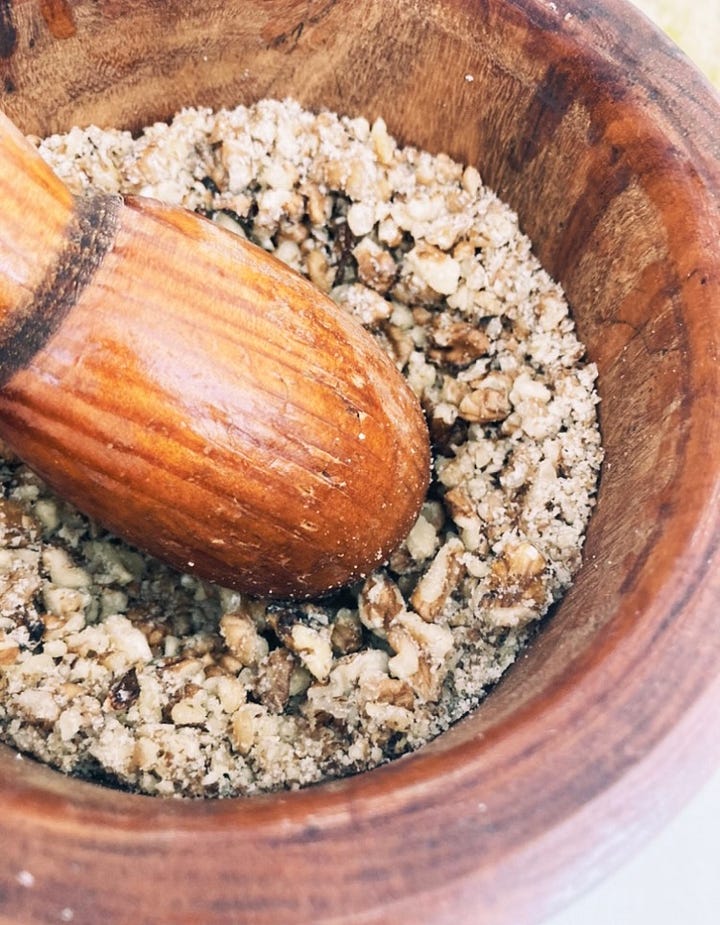
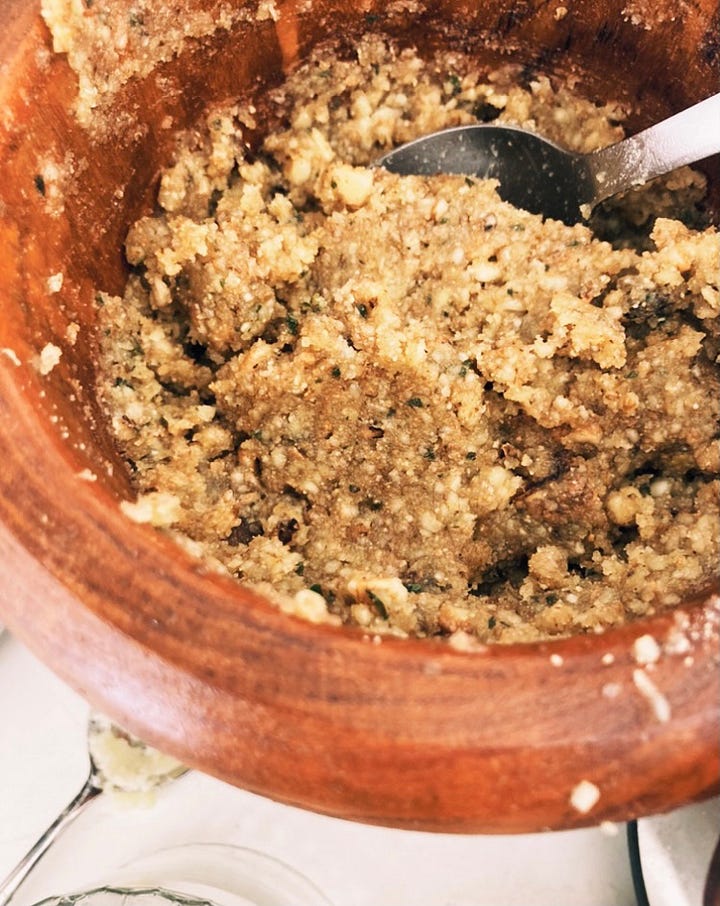
I had a love in with chestnut flour this past autumn swapping it into pancakes, a ciambellone alla zucca, savoury crespelle and dark chocolate chip and sea salt biscuits for the Christmas tin. I was waiting for our return to Contigliano to make the chestnut and potato gnocchi that I fancied covered with a pesto made with the walnuts from this year’s generous garden tree. Crushed using the local and rather phallic looking hand carved wooden pestle and mortar or “pilocca” that I swiped from my mother-in-law, it was a pesto that was worth the wait.

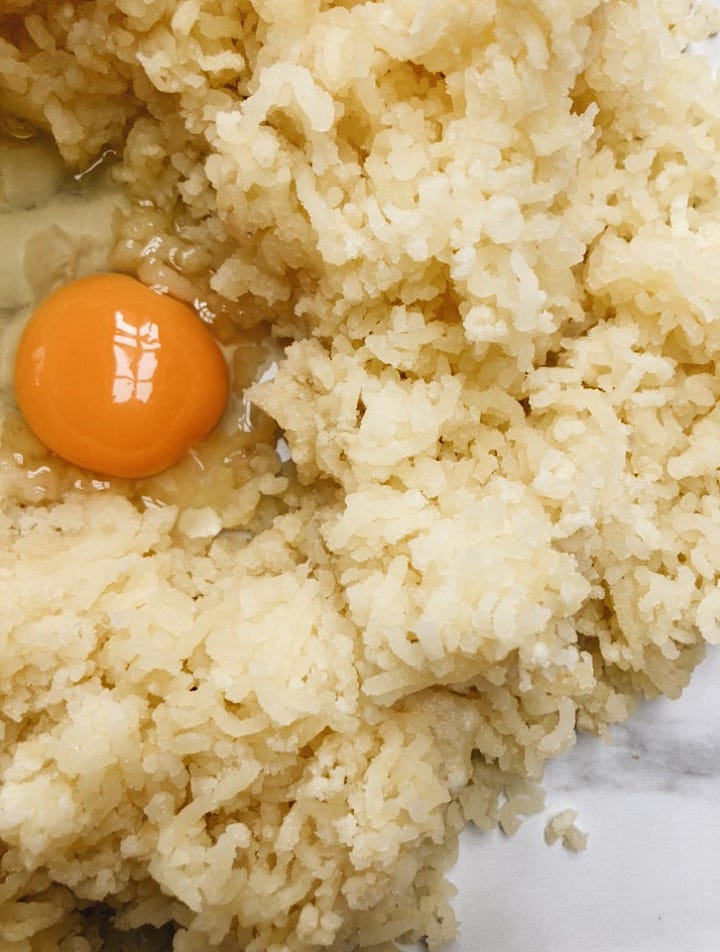
You can find the much sought after potato of Leonessa, by driving 30 minutes north of Antrodoco. Cultivated in the high plain, irrigated with the water from crystal mountain springs and cultivated to respect anything in its path, it’s a potato, as I’m sure you can imagine, that pairs really well with other products of the territory. And so I retrieved some from the cantina to rice and roll. Now, I learned how to make gnocchi in the local way by simply using flour and potatoes, with a result that is slightly more compact than one would imagine, but as I rolled and slowly added the flours* I just knew that these gnocchi were going to need an egg. Why? Because as I once read, with the words stuck in my head, it is hard to give the exact measurement of the flour required to make gnocchi because each potato absorbs differently depending on the type, the season, place and age. The result of dish was satisfactory, and so was the recipe bar the few splashes of starchy water that I should have added, that is until we reached Ireland and I retested the recipe to publish here.

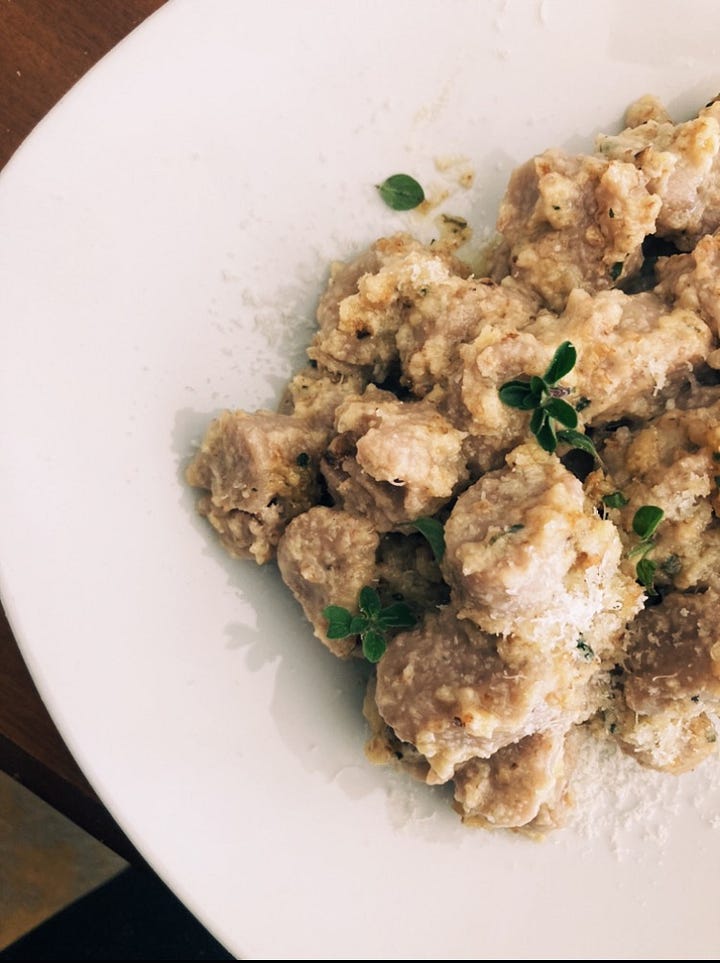
I find rolling gnocchi with a light touch to be relaxing and methodical as if someone has given me permission and 20 minutes to be a child again. So as I did this Ireland side with a bog standard Irish organic boiling potato, egg included, I found that I needed only half of the flour that was demanded by the potato of Leonessa. Tested 3 times, the lighter gnocchi recipe below is the real thing, but as mentioned, you must always be prepared to be flexible with the amounts of flour required.
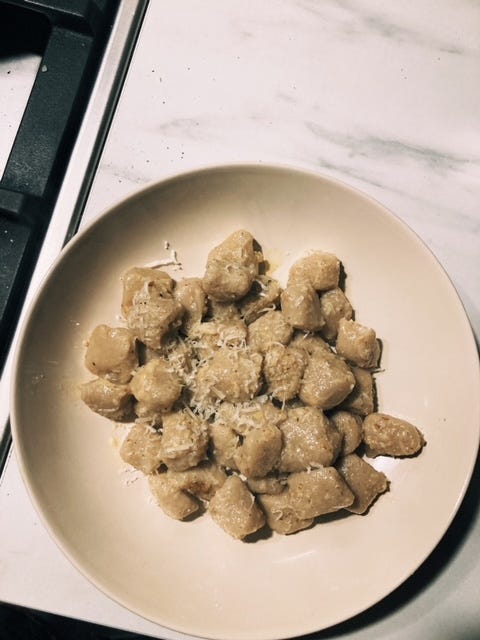
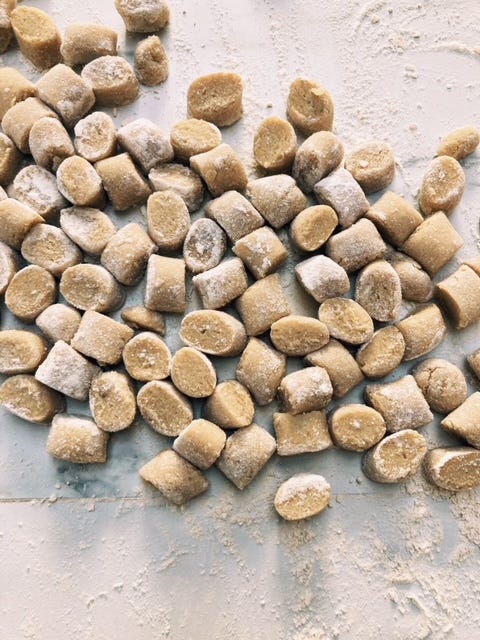
I won’t abandon my standard, naturally vegan and slightly more durable potato gnocchi recipe which I feel is more suited to some traditional recipes, but I am partial to a lighter egg included version that I will definitely embrace as the warm months roll in.
Gluten Free Potato and Chestnut Gnocchi
Serves 6-8
Ingredients:
1kg potato cooked and cooled
75g gluten free flour for pasta*, + more for dusting
75g chestnut flour
1 egg
Sea salt
Method:
Choose potatoes of an even size (nothing new or too floury). Give them a good rinse and put them in a large pot of water with their skins on. Bring to a boil, cover ¾ of the way, and then cook over medium heat with a rolling boil until tender salting halfway through.
Drain and leave until cool enough to handle but still warm to touch. Use a potato ricer to squeeze them into a large bowl or directly on to a clean work surface. Alternatively, peel and mash onto the same. Spread them out so that they are exposed to the air and allow them to cool.
Lightly flour your work surface, make a well in the middle of your potatoes and add your egg. Break yolk you’re your fingers and work it though the potato. Sprinkle half of the flour over your potatoes and season with sea salt. Work the flour into your potato lightly kneading and slowly adding what is remaining until you have a smooth but light dough that is no longer sticking to your hands*.
Cut large pieces from your dough and roll each into a sausage about 2cm thick. Slice into 2-3 cm lengths to resemble little pillows and push them to the side of your floured surface.
Meanwhile gently warm your pesto in a wide frying pan over the pot of boiling water. Set the warm pan aside and add a few tablespoons of oil to loosen further if necessary.
Bring a large and preferably wide pot of water to boil and add salt. Working in one or two batches, gently add your gnocchi when the water comes back to the boil. Cook for 2 to 3 minutes – as soon as they come up to the surface “a galla” they are ready.
Reserve a small cup of cooking water and use a wide slotted cooking spoon or mesh colander to drain and add gnocchi to the pan. Toss the pan a few times gently to coat the gnocchi or use a wooden spoon to gently stir adding a little bit of cooking water if necessary. Serve immediately.
Notes:
1. In Italy, it is easy to find gluten free flour that is used for pasta. If this is not your case them a general gluten free flour usually performs quite well. Tipo ‘00’ can be used where gluten free flour is not required. Amounts required slightly differ depending on flours and potatoes used but the technique is the same.
2. You might leave your gnocchi in the water for an extra 30-60 seconds when the water comes back to a boil, but as each batch performs differently depending on consistency, I tend not to risk it most of the time.
3. This recipe pairs well with a walnut pesto, a red or white sauce made from funghi trifolati, butter and sage or simple sauce of melted butter topped with freshly grated Parmigiano or Pecorino Romano. These gnocchi also pair really well with black truffle.
4. It is OK to make more gnocchi than you need. The next day they are moreish repassed in a hot frying pan lightly coated in olive oil crisped up and topped with a fried or poached egg, funghi trifolati or wilted spinach.
***
Walnut Pesto
Ingredients:
150g walnuts
60g of Pecorino Romano and/or Parmigiano Reggiano
1 clove of garlic
A handful of fresh marjoram
2 shot glasses full of olive oil
Sea salt
Method:
In a medium to large marble or wood pestle and mortar crush a fat clove of garlic until it is reduced to a paste. Add your nuts and crush in a circular motion to your desired consistency (rustic to smooth) using a spoon if necessary to release the mixture from the sides of the mortar to fold back into the mix. Once you have reached your desired consistency, break your cheese into small chunks and work them into the paste. Pick the leaves of your marjoram from their stems and work these in as well. Test for seasoning and add salt and pepper to taste. Slowly add a few shots of olive oil to achieve your desired consistency. This can be topped up at a later time.
Add your pesto to a clean and sterilised jar to be stored in the fridge no longer than a week.
Notes:
I first tried walnut pesto when my Italian friend and sister led me into her local gnocchi joint in Santa Margherita Ligure. We carried home two carefully wrapped packages of fresh gnocchi placed on gold trays together with classic pesto alla genovese and walnut pesto on the side to cook and enjoy at home.
I first recreated this pesto in my kitchen in Rome using fresh marjoram and I think that this herb really makes the recipe if you can get your hands on it. As a substitute you might play with punchy rocket, young nettle, rosemary and/or thyme. I love having walnut pesto to hand during the cold months to whip up a fresh plate of pasta and to smear across all things.




